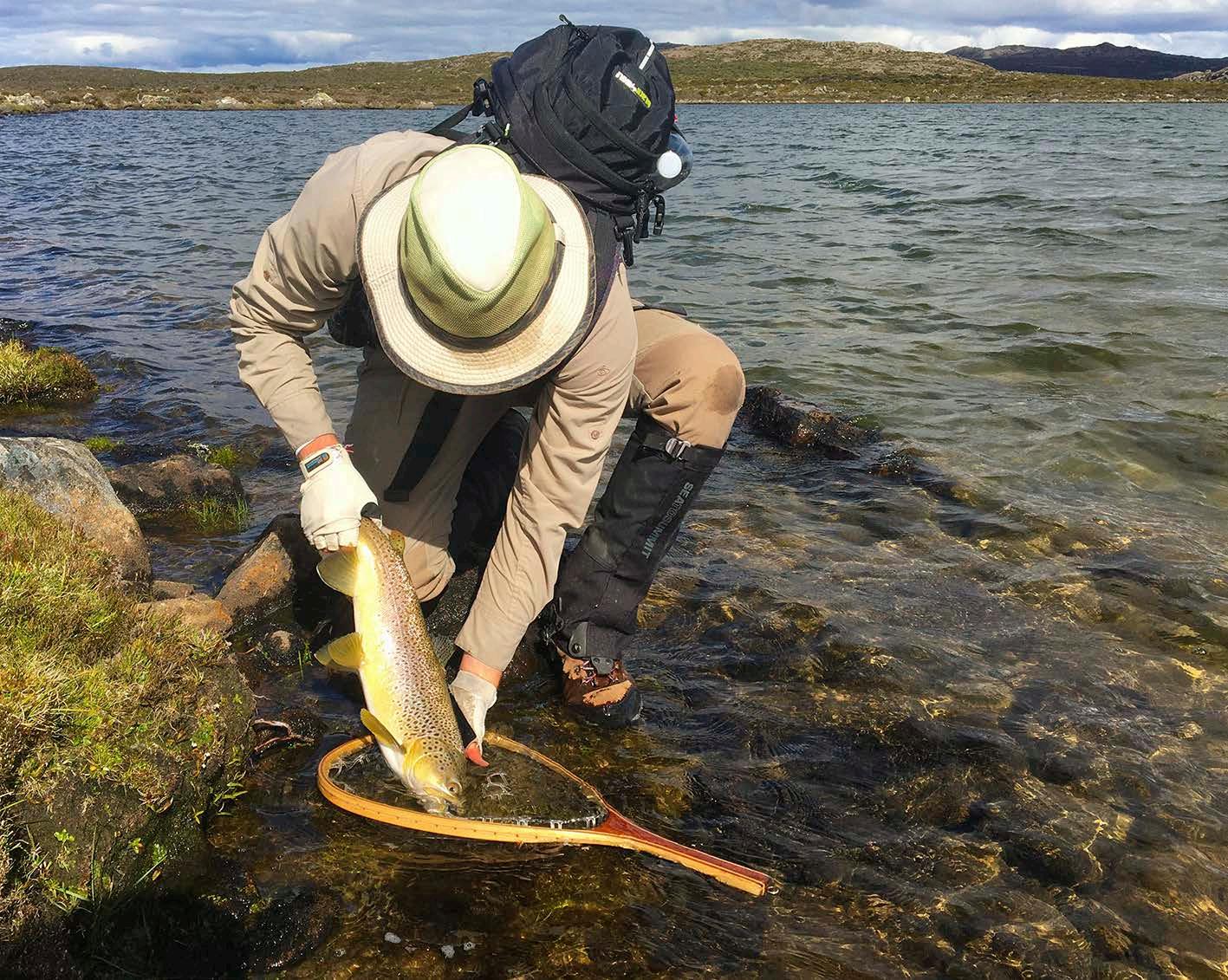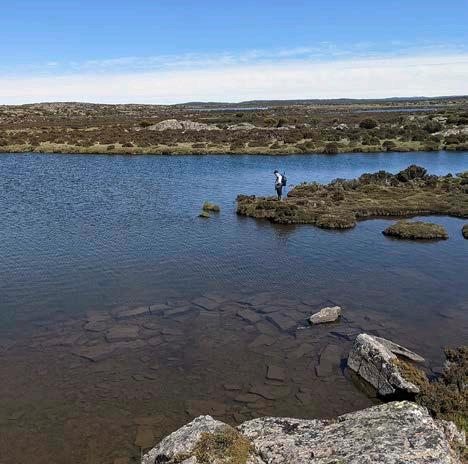
6 minute read
Pulling Dry Flies
A technique to explore on Western Lakes Trout
Logan Reid
Iremember a bluebird day, with only a few clouds in the sky, and just a slight breeze to put a small ripple on the water. We hiked 3 hours into a remote section of the western lakes to polaroid slow cruising brown trout from an elevated bank.
After walking along the edge for about an hour we found our first fish and it was a good’un! We were on a high bank and out of the corner of my eye I noticed a rather large fish in the water below me. This fish was hard up against the edge. I waited until the fish was behind a bush before I moved quickly into position. Whilst I was there my mate was still up on top of the hill, watching the fish moving up the bank sipping spinners and then turning to make its way back towards me.
I unhooked my little black spinner and stripped about a rod’s length of fly line from my reel. The fish was on the move and I put a cast out with the fly landing three metres off the bank the fish while the trout was still a little way away from me. The wind was blowing my fly in towards the bank and the fly was now about a metre off the bank. I wanted to recast the fly out further but heard the fish rise on the other side of the bush so I knew he was close and I decided to leave my fly there. This was a good decision with the fish slow cruising less than a metre off of the bank. As I saw the fish appear from behind the bush I started to move even closer to the bush as to conceal myself from the fish. He was right there in front of me in the water, I could see every spot on him and see how good he was in condition. He was heading over towards my fly and it seemed he didn’t notice it there so I decided to add some movement to the dry just by lifting my rod tip, giving the fly a small bit of movement.
The fish saw the movement and headed over to my fly and sat under it for about three seconds which felt like ten seconds at the time. I started to worry I was going to get a big refusal but then this big brown softly sipped down the dry and started to head away from me. I set the hook and it came up solid. I was on! The fish took off with a couple of good runs and jumps, my reel was screaming and the line was cutting the water in half. After about 5 minutes of fighting this fish, he was tiring and I could get the net to him. He was a good five-pound brown and a great first fish out of the western lakes. This memory will always stick with me but is only one of many great memories I’ve gathered from spending time in the area.
Inducing a take with movement

Trout are predatory fish and often look for movement. Sometimes a bit of movement in your fly will excite a fish and induce a take. There have been times on the river or lake that I’ve presented a dry fly nicely to a fish and had the fish swim straight under my fly without even acknowledging it. The fish either had not seen my fly or saw it and didn’t think it was lifelike enough, so adding movement to your fly will give your fly life and the fish will see and sense the movement of your fly. You can add movement to your fly if you have good line contact by just lifting your rod tip slightly so your dry skates across the surface of the water. Another way to add movement to your fly is to strip a small amount of line which will again give your fly movement. Moments later the fish you have cast to has charged over and inhaled your fly.
Fly Selection for the Western Lakes

Lakes in the western lakes that have good weed beds will get good hatches of duns and spinners in them in the warmer months. Caddis and stoneflies can be found in lots of the lakes up there. The evening caddis hatch can be a big event bringing lots of fish to the edges. Terrestrial insects such as grasshoppers, crickets and beetles are also on the menu for western lakes trout, so it is about matching the hatch on the day when you’re up there. Some of my favourite flies for the western lakes are foam or dear hair beetles, small parachute black spinners, possum fur emergers and elk hair caddis
Setting an ambush fly
Sometimes on pressured waters or with a very wary fish, you won’t be able to cast if the fish is anywhere near you. They will spook from your line being in the air or landing on the water, and especiall from your fly rod or line flashing in the sun. You want the first thing that the fish notices to be your fly and not your fly rod waving in the air. If the fish are like this your best shot is to put out an ambush fly. To do this you’ll need to watch a particular fish for a while to find its beat (The area that a fish feeds in) By observing a fishes beat you will be able to put together a plan and set an ambush fly in its feeding line. By doing this you are not casting over a fish or disturbing it with your line. By the time the fish comes back around, any ripple or disturbance your line may have made will have dissipated and you now have a perfect trap of fool wary brown trout.

Small dries and light tippet
Big trout big flies, make’s sense, right? Well yes, big trout will take big flies but often for trout to get to a decent size they need to have something going for them, a bit of a sixth sense, knowing you’re near or just really picky in what they will eat. So throwing a size #10 hopper or a big stimulator won’t be the best option for a wary old brown trout. So to downsize your fly and use a light tippet may be the way to fool these fish. With a small and fine fly, you will be able to present your fly nice and softly without spooking a wary fish. Using a two or three-pound tippet on a big fish may sound crazy but a 6-pound fish doesn’t actually pull six pounds of pressure when he takes off. Having a light drag on your reel will also protect the light tippet. With a large fish, if you have a high rod tip and a light drag it may seem difficult to steer a large trout but using low side pressure will help steer a large fish and change its direction so you can land it. All you need to remember with side pressure is if a fish is moving to the right and for some sticks, you will need to put some low left side pressure onto the fish to change its direction and vice/versa if you want to change a fish going to the left.


Getting There
The Western Lakes is a huge area covering approximately 140,000 hectares with thousands of lakes and tarns (tarns are a body of water not connected to the main flow of water until the area is in flood) with huge trout being found in some areas. Being such a big area there are many ways to access the western lakes. One of them being the nineteen lagoons. Access to the area is via Liawenee and Lake Augusta Road which lies on the western shore of Great lake and is one of the most popular areas of the western lakes. Some of the most popular lakes in the area are Lake Botsford, Lake Ada and Lake Augusta. If you are travelling from Launceston to the Nineteen Lagoons it will take you about an hour and 50 minutes to get there and two hours and 15 minutes from Hobart. Other areas of access are from Lake Mackenzie up through Devils Gullet which is about an hour and 40 minutes from Launceston and three hours and 40 minutes from Hobart. The Walls of Jerusalem National Park is an hour and 40 minutes from Launceston and is three hours and 40 minutes from Hobart.











